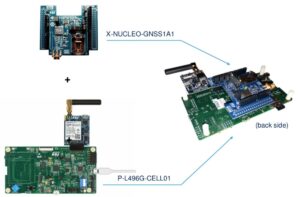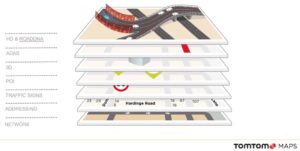The new STM32ODE Function Pack, the FP-ATR-TOMTOM1 is the first software package for embedded systems to bring multiple TomTom Maps APIs to IoT development platforms, and we’re announcing today that the X-NUCLEO-GNSS1A1 GNSS/GPS expansion board built around Teseo-LIV3F, and that is at the center of this Function Pack, is now available at online retailers or on our store for $35. Thanks to a collaboration between ST and TomTom, developers can now use our cellular and GNSS/GPS development boards to call our certified partner’s online servers and offer mapping as well as location features within their embedded applications. The Function Pack, part of STM32ODE Open Development Environment, focuses primarily on four APIs: routing, geocoding, traffic, and search. It first targets asset tracking and fleet management applications, even if TomTom’s pricing structure ensures that products with a more mainstream appeal can also benefit from it.
GNSS/GPS applications are now ubiquitous thanks to their popularity on smartphones. However, if tracking the user’s geographical location when driving is one thing, knowing exactly the whereabouts of thousands of assets at the same time while using an interface that can make sense of all this information is another. And this is a problem that many developers quickly encounter as they start designing their industrial application, only to realize that service providers and tools for consumer applications can’t adequately meet their needs. Indeed, many competitors don’t have the right APIs to track large fleets correctly, or their solutions can be slow and hard to use, which is why we worked with TomTom to take what was complex and made it simple.
The ST Ecosystem

The FP-ATR-TOMTOM1 comes with all the drivers, middleware, and source files that developers need to start a project in an IDE (Integrated Development Environment). We even tested the package on the ARM toolchains from IAR systems and Arm Keil, as well as the free System Workbench for STM32 (SW4STM32), the latter massively reducing the barrier to entry. The Function Pack is part of the STM32Cube, which makes it highly portable. Hence, once designers select the microcontroller of their choice, it’ll be relatively straightforward to port their code from the prototype. However, to make our partnership with TomTom even more accessible, we also offer pre-compiled binaries for the NUCLEO-F401RE and 32L496GDISCOVERY boards. As a result, even someone with minimal experience in embedded systems or programming can start experimenting with our solution and see how the TomTom maps and services can add a myriad of features to an application.
The binaries that we precompiled use the cellular modem of the Quectel UG96 daughter board to connect to the TomTom servers. The easiest solution is thus to get the P-L496G-CELL01 Discovery Pack, which includes the modem and a motherboard almost identical to the 32L496GDISCOVERY, but without the display, making this our most feature-rich cellular discovery kit ever. Developers who own the cellular modem can also use it with the NUCLEO-F401RE. However, since the Quectel card uses our STMod+ connector, they will have to plug in the X-NUCLEO-STMODA1 card first to add the necessary interface. Additionally, the jumper JP5 needs to be in the U5V position on the Nucleo board. Finally, users need to place our X-NUCLEO-GNSS1A1 board at the top of the stack and drag and drop the correct binary to load it onto the microcontroller.
The TomTom Maps APIs

Once users activate their SIM card and make sure they can connect to their cellular network, the next step is to register at the TomTom developer portal to get an API key. It will enable engineers to start using all of the TomTom APIs for free. Indeed, our partner allows for up to 2,500 API transactions per day at no cost to the user, making this a particularly exciting platform for prototyping. Since teams tend to work on their designs with only a few devices active at a time, 2,500 transactions will be more than enough. Once companies start selling their products and need more allowance, TomTom offers pay-as-you-grow plans to avoid unnecessarily burdening startups that can’t always predict demand accurately. On the other end of the spectrum, large companies can benefit from volume discounts as their products become increasingly popular.
We published a Quick Start Guide to walk developers through the steps of using the binaries. Once they add their API key to the right header file, they can drag and drop the application onto their development board and open a terminal to interact with the system. If the GNSS/GPS module doesn’t capture a strong enough signal to output values, there are a few coordinates in memory that developers can use to start playing with the application. Regardless, they can now use the TomTom Maps APIs to do reverse geocoding, meaning displaying the street address that matches the GNSS/GPS coordinates or to show a map of the location. In this case, the Terminal will display a cartographic environment in a web browser. The system is very lightweight, and TomTom sends an image back to the user to ensure the system can handle the payload without bogging it down.
Two Companies, So Many Possibilities

The FP-ATR-TOMTOM1 also has the significant advantage of encrypting all communications between the user and TomTom’s cloud through a TLS protocol, which means that by merely reusing the source code of our application, companies can already protect themselves against man-in-the-middle attacks, for instance. Additionally, because the Function Pack leverages the STM32Cube environment, developers can start using other ST expansion boards than those that the binaries support, such as our X-NUCLEO-S2868A1, which integrates our S2-LP sub-gigahertz transceiver. For example, they could use it as a substitute to the cellular modem to connect to a Low Power Area Network (LPWAN), such as LoRa or Sigfox, among others, opening their product to longer battery life and broader coverage.
- Learn more about the FP-ATR-TOMTOM1
